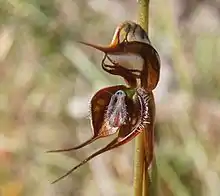Pterostylis maxima
Pterostylis maxima, commonly known as the large rustyhood, is a plant in the orchid family Orchidaceae and is endemic to south-eastern Australia. It has a rosette of leaves at its base and up to eight relatively large, dark brown flowers with transparent "windows" and a thin, dark insect-like labellum.
| Large rustyhood | |
|---|---|
 | |
| Scientific classification | |
| Kingdom: | Plantae |
| Clade: | Tracheophytes |
| Clade: | Angiosperms |
| Clade: | Monocots |
| Order: | Asparagales |
| Family: | Orchidaceae |
| Subfamily: | Orchidoideae |
| Tribe: | Cranichideae |
| Genus: | Pterostylis |
| Species: | P. maxima |
| Binomial name | |
| Pterostylis maxima | |
| Synonyms[1] | |
Description
Pterostylis maxima, is a terrestrial, perennial, deciduous, herb with an underground tuber. It has a rosette of between six and twelve egg-shaped leaves at the base of the flowering spike, each leaf 15–45 mm (0.6–2 in) long and 10–18 mm (0.4–0.7 in) wide. Between two and eight dark reddish-brown flowers with transparent sections, each flower 35–60 mm (1–2 in) long and 12–14 mm (0.5–0.6 in) wide are borne on a flowering spike 200–350 mm (8–10 in) tall. Four to six stem leaves are wrapped around the flowering spike. The dorsal sepal and petals are joined to form a hood called the "galea" over the column with the dorsal sepal having a thread-like tip 7–12 mm (0.3–0.5 in) long. The lateral sepals are wider than the galea, dished, densely hairy on their outer edges and suddenly taper to thread-like tips 25–35 mm (0.98–1.4 in) long and parallel to each other. The labellum is reddish-brown, thin and insect-like, 6–8 mm (0.2–0.3 in) long and about 4 mm (0.2 in) wide. The "head" end is swollen with two long bristles and there are up to 8 to 12 shorter bristles on each side of the "body". Flowering occurs from October to November.[2][3][4]
Taxonomy and naming
Pterostylis maxima was first formally described in 1989 by David Jones and Mark Clements from a specimen collected near Bendigo and the description was published in Australian Orchid Research.[1] The specific epithet (maxima) is a Latin word meaning "greatest" or "largest".[5]
Distribution and habitat
The large rustyhood occurs in scattered populations south from Temora in New South Wales and across Victoria to the south-east bioregion of South Australia. It grows in woodland, open forest and mallee.[2][3][4]
Conservation
Pterostylis maxima is described as "vulnerable" in Victoria and as "endangered" in South Australia.[4][6]
References
- "Pterostylis maxima". APNI. Retrieved 20 May 2017.
- Jones, David L. (2006). A complete guide to native orchids of Australia including the island territories. Frenchs Forest, N.S.W.: New Holland. p. 326. ISBN 978-1877069123.
- Jones, David L. "Pterostylis maxima". Royal Botanic Garden Sydney: plantnet. Retrieved 20 May 2017.
- Jeanes, Jeff. "Pterostylis maxima". Royal Botanic Garden, Melbourne: vicflora. Retrieved 20 May 2017.
- Brown, Roland Wilbur (1956). The Composition of Scientific Words. Washington, D.C.: Smithsonian Institution Press. p. 516.
- "Census of South Australian Plants - Pterostylis". State Herbarium of South Australia. Retrieved 20 May 2017.